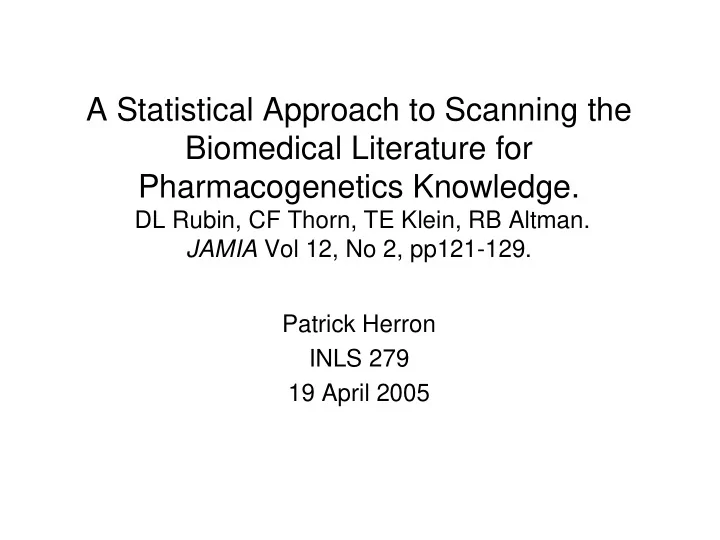

A Statistical Approach to Scanning the Biomedical Literature for Pharmacogenetics Knowledge. DL Rubin, CF Thorn, TE Klein, RB Altman. JAMIA Vol 12, No 2, pp121-129. Patrick Herron INLS 279 19 April 2005
A Statistical Approach to Scanning the Biomedical Literature for Pharmacogenetics Knowledge • What’s the problem? • Genetic basis of drug response • Predict individual drug responses • What genes produce or alter a drug effect? • How do we capture gene-drug relationships?
The stakes • Big problem of identifying the right candidate drug target for a specific disease • Currently 95% of candidates fail to produce a drug – even smaller percentage of targets • Sequencing & analysis has failed b/c it has generated too much information, w/decrease in signal-to-noise ratio • Failure usually due to toxicity or inefficacy • “Quantal step” needed in discovery Roses AD, et al. Disease-specific target selection: a critical first step down the right road. Drug Discovery Today . Vol 10, No 3, February 2005, 176-189.
Can Rubin et al help us? • Can the system the authors propose overcome the information explosion by helping to identify efficacious (& nontoxic) drugs? • Can we use the literature to perform in silico validation? • Can their system increase the signal?
Gene-target-disease specificity • The drug-gene relationship is really better thought of as a triune relationship between a target molecule, its associated/potential disease impacts, and genes related to the target and/or the disease • Best relationships for discovery are highly specific • Genome-level data is highly specific, but highly noisy
Narrowing the relevant literature • How do we identify Medline citations that contain data about SPECIFIC drug-gene relationships? • No comprehensive knowledge base that contains all drug-gene relationships data exists • Manual task of identifying literature/db support for gene-drug relationships too time consuming
Method • Pharmacogenetics corpus – manually selected drug-gene articles (standards?) • Article Preprocessing • Features describing Pharmacogenetics articles • Classification methods • Scanning Medline • Manual validation
Factors • Classification methods – Naïve Bayes – Regression – Log likelihood • Feature representations – 25 best MeSH terms – 150 best MeSH terms – All MeSH terms – All MeSH terms with filtering – 150 best words – 350 best words – All words
Results • Model performance – precision, recall, F measure • MeSH terms generally showed higher precision • Words yielded better recall • Log likelihood on all MeSH terms performed best overall (by F measure)
Discussion • MeSH terms show high precision and low recall—better precision than words alone • What do you think is the heuristic drug- gene filter they’re talking about?
Questions • Is their method biased against ML approaches? Too few features? Training set too small? • How much is a literature search going to get us? • Do Rubin et al understand that a drug is embodied in the literature as a target/target class to specific disease pairing? • Are we getting better information or just getting more information? • How specific is the information identified by the system described in Rubin et al ? • Is it strength of association (figure 3) or just merely frequently written about (re: fashionable)? Authors claim that “as the number of articles containing a particular co- occurrence increases, a true association becomes more likely” (128)
Recommend
More recommend